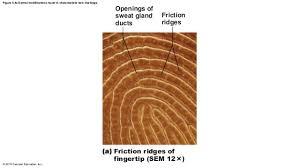Which layer of the skin - dermis or epidermis - is better nourished?
The dermis is connective tissue, which is vascular, so its cells would be better nourished than those of the epidermis, which is avasular epithelium.
While walking barefoot, Jeremy stepped on a rusty nail that penetrated the epidermis. Name the layers the nail pierced from the superficial skin surface to the junction with the dermis.
Since the sole of the foot has thick skin, the layers from most superficial to deepest would be the stratum corneum, stratum lucidum, stratum granulosum, stratum spinsosum, and stratum basale.
What is the major function of the stratum basale?
The stratum basale undergoes almost continuous mitosis to replace cells lost by abrasion.
Why are the desmosomes and tight junctions connecting the keratinocytes so important?
The skin is subjected to a lot of abrasion and physical trauma. The demosomes, which are connecting junctions, help to hold the cells together during such stress. The tight junction helps to reduce water movement through the skin.
Suppose that the dead cells of the stratum corneum did not shed from your body, but rather stuck to it and continued to accumulate. What problems might this cause?
Some possible answers to this question are:
1. You would either be unable to grow, or there would be big cracks in the stratum corneum as you grow.
2. The thickness of the skin would impede joint movement so it would be hard to move.
3. You could not be able to lose heat through your skin as effectively as you do now.
4. Your skin would be very heavy to carry around after a while.
What typoe of tissue makes up the papillary and reticular dermis?
The papillary dermis consist of areolar connective tissue, and the reticular dermis consist of dense irregular connective tissue.
You have just gotten a paper cut. It is very painful, but it doesn't bleed. Has the cut penetrated into the dermis or just the epidermis?
Because there is no bleeding, the cut has penetrated into the avascular epidermis only.
Stefan's front bike tire slipped on a patch of gravel as he road to work. He needed five stitches to close the cut above his left eye. The split skin ran along the cleavage line. Is Stephan likely to have a major scar or is the wound likely to heal cleanly? Explain
Since Stefan's wound runs along a cleavage line, it is likely to heal much more cleanly than it would if it ran perpendicular in the cleavage lines.
chart of dermis and epidermis labeled
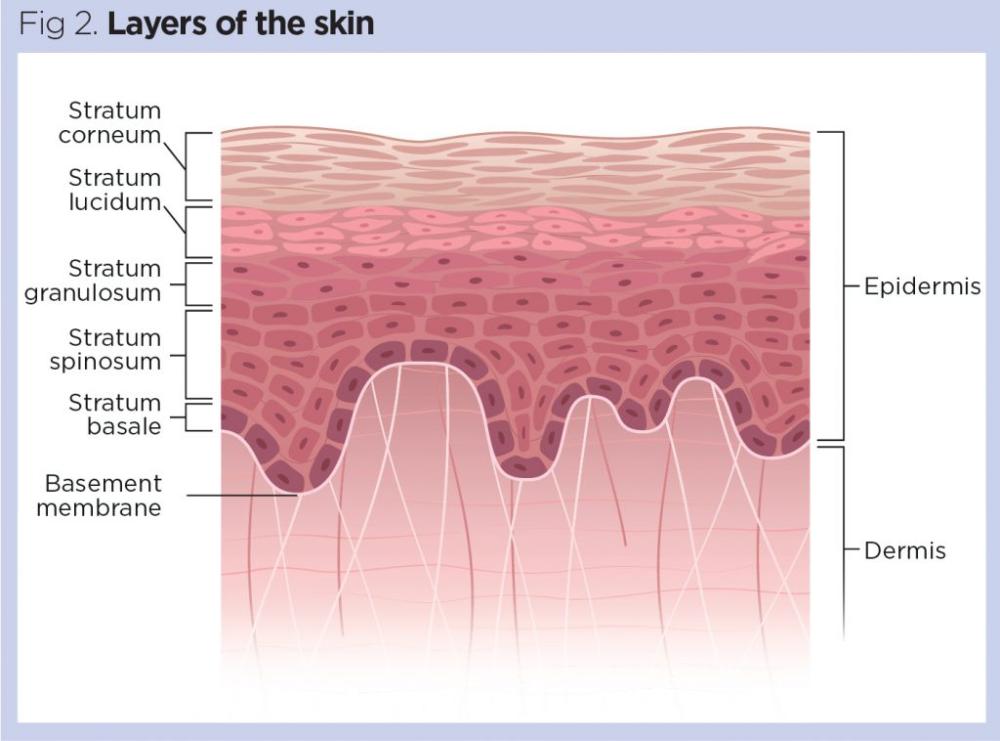
Melanin and carotene are two pigments that contribute to skin color. What is the third and where is it found?
The third pigment that contributes to skin color is hemoglobin, the pigment contained in read blood cells found in blood vessels of the dermis.
Which alteration in skin color may indicate a liver disorder?
Jaundice, a yellow cast to the skin due to the deposit of yellow bile pigments in the body tissues, may indicate a liver disorder.
Why is having you hair cut painless?
There are no nerves in the hair, so cutting hair is painless.
Hair follicle diagram
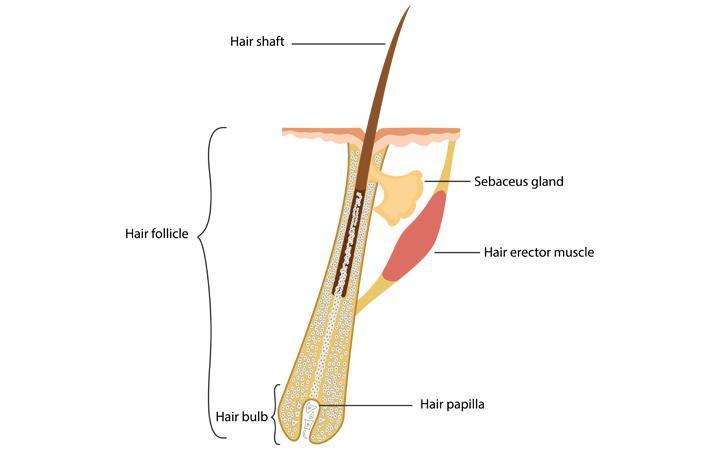
What are the three concentric regions of the hair follicle?
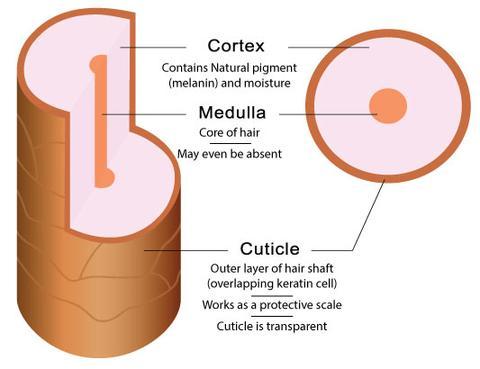
Why is the lunule of the nail white instead of pink like the rest of the nail?
The lunule of the nail is white because the thick nail matrix that underlies it blocks the rosy color of the dermal blood supply from showing through.
Why are nails so hard?
Nails are hard because the keratin they contain is the hard keratin variety.
Which cutaneous glands are associated with hair follicles?
Sebaceous glands and apocrine glands are associated with hair follicles.
When Anthony returned home from a run in 85 degree weather, his face was dripping with sweat. Why?
His autonomic nervous system activated his eccrine sweat glands and caused heat-induced sweating in order to cool the body.
What is the difference between heat-induced sweating and "cold sweat", and which variety of sweat glands is involved?
Heat-induced sweating occurs all over the body when we are overheated. A cold sweat is emotionally induced sweating that begins on the palms, soles, and armpits and then spreads to other body areas. Both types of sweating are primarily produced by the eccrine sweat glands.
Sebaceous glands are not found in thick skin. Why is their absence in those body regions desirable?
The palms of the hands and soles of the feet are thick skin areas. It would be dangerous to have oily soles, and oily palms would decrease the ability of the hands to hang onto things.
What chemicals produced in the skin help provide barriers to bacteria? List at least 3 and explain how the chemicals are protective.
The low pH of the skin secretions (acid mantle) inhibits division of bacteria, and many bacteria are killed by dermcidin in sweat, bactericidal substances in sebum, or natural antibiotics called defensins produced by skin cells. Damaged skin secretes cathelicidins that are effective against a certain strain of strep bacteria.
Which epidermal cells play a role in body immunity?
The epidermal dendritic cells play a role in body immunity
How is sunlight important to bone health?
Sunlight causes the skin to produce a precursor of vitamin D from cholesterol. Vitamin D is essential for absorption of calcium from the diet, and calcium is a major component of bone.
When blood vessels in the dermis constrict or dilate to help maintain body temperature, which type of muscle tissue that you learned about in histology acts as the effector that causes blood vessel dilation or constriction?
The effector in this case is smooth muscle
Which type of skin cancer develops from the youngest epidermal cells?
Basal cell carcinoma develops from the youngest epidermal cells
What name is given to the rule for recognizing the signs of melanoma?
The ABCD rule helps one to recognize signs of melanoma
The healing of burns and epidermal regeneration is usually uneventful unless the burn is a third-degree burn. What accounts for this difference?
First and second degree burns can be healed uneventfully by regeneration of epidermal cells as long as infection does not occur. Third degree burns destroy the entire depth of skin and regeneration is usually not possible. Infection and loss of body fluid and proteins make recovery problematic.
Although the anterior head and face represent only a small percentage of the body surface, burns to this area are often more serious than those to the body trunk. Why?
Burns to the face are serious because damage to the respiratory passageways can occur in such burns.
Which epidermal cell type is most numerous?
keratinocyte
Which cell functions as part of the immune system?
dendritic cell
The epidermis provides a physical barrier due largely to the presence of?
keratin
Skin color is determined by?
a. the amount of blood
b. pigments
c. oxygenation level of blood
The sensations of touch and pressure are picked up by receptors located in?
the dermis
Which is not a true statement about the papillary dermis?
a. it is largely areolar connective tissue
b. it is most responsible for the toughness of the skin
c. it contains nerve endings that respond to stimuli
d. it is highly vascular
b. it is most responsible for the toughness of the skin
Which of the following is not an epidermal derivative?
a. hair
b. sweat gland
c. sensory receptor
d. sebaceous gland
c. sensory receptor
An arrector pili muscle?
can cause a hair to stand up straight
The product of this type of sweat gland includes protein and lipid substances that become odoriferous as a result of bacterial action?
apocrine gland
Sebum
a. lubricates the surface of the skin and hair
b. consists of cell fragments and fatty substances
c. in excess may cause seborrhea
The rule of nines is helpful clinically in?
estimating the extent of a burn
Distinguish clearly between first, second and third degree burns.
First degree burns damage only the epidermis, second degree burns damage the epidermis and the upper region of the dermis, and third degree burns damage the entire thickness of the skin (the entire epidermis and dermis)
Why does skin wrinkle and what accelerates the wrinkling process?
Wrinkling is due to the loss of the elasticity of the skin along with the loss of the subcutaneous tissue, and is hastened by exposure to the sun.
Which epidermal cells contain keratonhyaline and lamellar granules?
Stratum granulosum, 3-5 cell layers, contains diamond shaped cells with keratohyalin granules and lamellar granules.
Is a bald man really hairless? Explain
No, the follicular growth cycles become so short that many hairs never even emerge from their follicles before shedding.
Count Dracula, the most famous vampire, rumored to have killed at least 200k people, was based on a real person who lived in eastern Europe about 600 years ago. he was indeed a monster, although he was not a real vampire. The historical Count Dracula may have suffered from?
(a) Porphyria- Certain enzymes needed to form the heme of hemoglobin of blood are lacking. Without the enzymes, metabolic intermediates of the heme pathway called porphyrins build up, spill into the circulation, and eventually cause lesions throughout the body, especially when exposed to sunlight. The fingers, toes, and nose are disfigured, gums degenerate and teeth become prominent.
On an outline diagram of the human body, mark off various regions according to the rule of nines. What percentage of the total body surface is effected if the skin over the following body parts is burned?
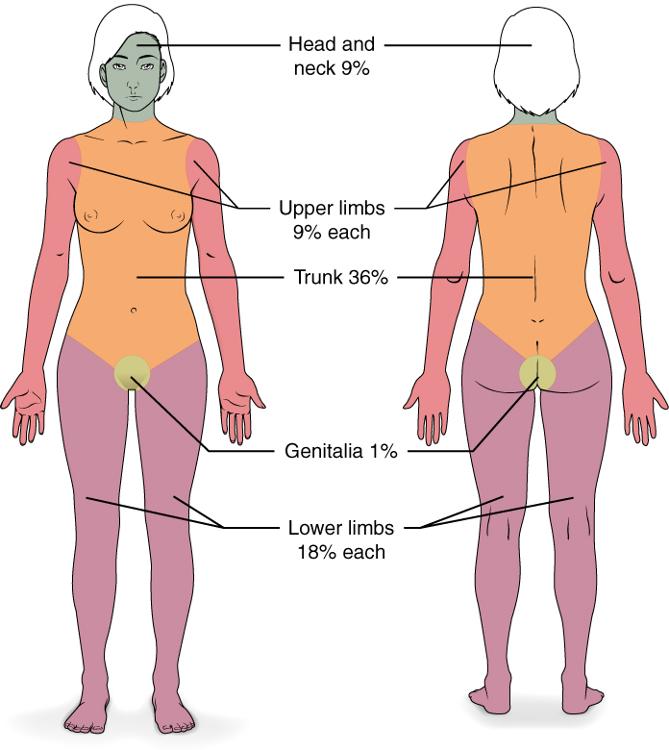
Several methods are available to estimate the percentage of total body surface area burned. Rule of Nines - The head represents 9%, each arm is 9%, the anterior chest and abdomen are 18%, the posterior chest and back are 18%, each leg is 18%, and the perineum is 1%
Dean, a 40-year old aging beach boy, is complaining to you that although his suntan made him popular when he was young, now his face is all wrinkled, and he has several darkly pigmented moles that are growing rapidly and are as big as large coins. He shows you the moles, and immediately you think "ABCD". What does that mean and why should he be concerned?
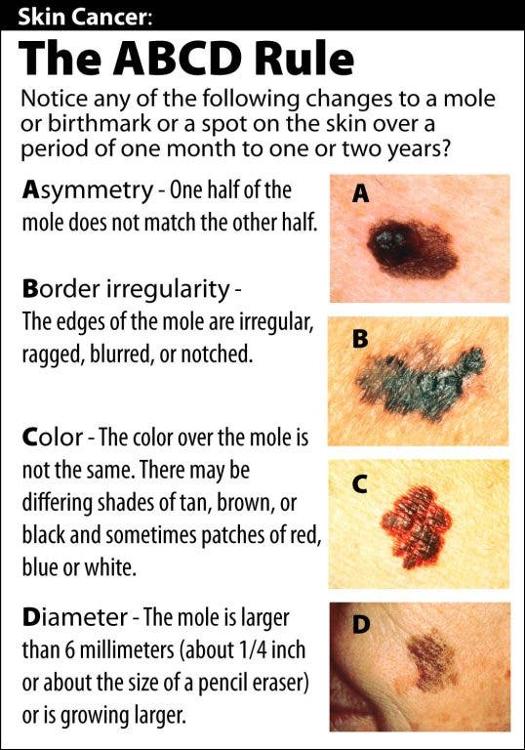
ABCD the rule for melanoma recognition.
Patients with third-degree burns demonstrate the loss of vital functions performed by the skin. What are the two most important problems encountered clinically with such patients? Explain each in terms of the absence of skin.
The two most important problems encountered clinically with a victim
of third-degree burns
are a loss of body fluids resulting in
dehydration and an electrolyte imbalance, and the risk
of
infection. Intact skin effectively blocks not only the
diffusion of water and water-soluble
substances out of the body,
but acts as a barrier limiting the invasion of various
microorganisms.
You go to the beach to swim on an extremely hot, sunny summer afternoon. Describe two ways in which your integumentary system acts to preserve homeostasis during your outing.
Chemical barriers of protection: Melanin provides a chemical pigment
shield to prevent UV damage to skin cells.
Body temperature
regulation: The body releases sweat (body heat) and as that evaporates
off the skin it cools the body.
Describe the process of hair formation, and list several factors that may influence
a. growth cycles
b. hair texture
Each follicle goes through growth cycles. In the regressive phase, the hair matrix cells die and the follicle base and hair bulb shrivel somewhat, dragging the hair papilla upward to abut the region of the follicle that does not regress. The follicle enters a resting phase for one to three months. The cycling part of the follicle regenerates and the matrix proliferates again and forms a new hair to replace the old one that has fallen out or will be pushed out by the new hair.
Explain each of these familiar phenomena in terms of what you learned in this chapter.
a. pimples
b. dandruff
c. greasy hair and "skinny nose"
d. stretch marks from gaining weight
e. freckles
(a) Accumulated sebum blocks a sebaceous gland duct, a white head
appears. If the material oxidizes and dries, it darkens to form a
blackhead.
(b) Shingle-like cell remnants of the stratum corneum
(cornified cells).
(c) The arrector pili muscle contracts to
force sebum out of the hair follicles on to the skins surface (shiny
nose), and the sebum directly on the hair shaft results in greasy
hair.
(d) Silvery white scars (striae).
(e) Local
accumulations of melanin.
Why are there no skin cancers that originate from stratum corneum cells?
Because the cells in the stratum corneum are dead.
A man got his finger caught in a machine at the factory. The damage was less serious than expected, but the entire nail was torn off his right index finger. The parts lost were the body, root, bed, matrix, and eponychium of the nail. First, define each of these parts. Then, tell if this nail is likely to grow back.
Body- visible attached portion
Root- embedded in the
skin
Bed- extends beneath the nail
Matrix- thickened
proximal portion of the nail bed
Eponychium- proximal nail fold
projects onto the nail body
No, the nail is not likely to grow back because the matrix was lost.
Mrs. Gaucher received second-degree burns on her abdomen when she dropped a kettle of boiling water. She asked her doctor if she would need a skin graft. What do you think he told her?
Very serious deep second and full-thickness burns require skin graft surgery for quick healing and minimal scarring. In the case of large burn size, patients will need more than one operation during a hospital stay.
Integumentary System
Includes skin, nails, hair, glands (ceruminous = earwax; sebaceous = oil around hair follicles; sudoriferous = sweat glands)
Study of the integumenty system is
Dermatology
Integument is only made up of
epidermis and dermis
Functions of skin include
resist trauma; resist dehydration, vitamin D synthesis: protects from UV lights; participates in thermoregulation; involved in sensatoin of touch/temperature/pressure; useful in nonverbal communication.
Vitamin D synthesis
First state in production of vitamin D3 called cholecalciferol is synthesized from a derivative of the steroid cholesterol in the skin
Thermoregulation
Lose excess heat from and keeps from loss of heat when needed to be retained.
Epidermis
Made up of keratinized stratified squamous epithelium
lakes blood vessels - avascular
Layers of Epidermis
Stratum basale, stratum spinosum, stratum granulosum, stratum lucidem, stratum corneum
Stratum Basale
contains stem cells which form all cells above them
Stratum Spinosum
named for the look in histology preps which is an artifact of preservation
Langerhans cells
Antigen presenting cells of immune system found in stratum spinosum
Stratum Granulosum
This layer is slowly replacing the cell contents with keratin as granules
Stratum Lucidem
Only found in thick skin!!!! Lucidem means clear
Stratum Corneum
the top layer of completely dead cells, completely filled with keratin. therefore, waterproof and dead... so can resist abraision
Dermis
Connective tissue
Contains: pressure sensors, i.e. Messiner's corpulsles and Merkel Discs: Blood vesselsL hair roots (but the hair lies in a follicle which is invagination of the epidermis into the dermis): contains Sudoriferous and sebaceous glandsL contains Erector Pili muscles to goosebumps
Broken collagen in this connective tissue layer cause Striae (stretch marks)
Hypodermis
Not part of the integument
is made up of connective tissue
Contains: Adipose tissue (fat) and largest blood vessels
is where you deliver injectables when they are given subcutaneously also termed hypodermal injection
Two types of normal pigments which contribute to color of a person's skin
Eumelanin
Pheomelanin
Eumelanin for skin
Eu means "true"; so its considered true melanin, therefore brownish black colored.
Pheomelanin for skin
which either contributes a reddish or a yellowish coloration to skin
Other normal factors affecting skin color include
Hemoglobin
Carotene
Hemoglobin for skin
gives pink undertones
Carotene for skin
found in yellow to orange vegatables which make skin orange like
Abnormal skin colors and their cause include
Cyanosis
Erythema
Pallor
Albinism
Jaundice
Hemotomia
Cyanosis is
due to a low oxygen carriage in the blood
Erythema is
abnormal redness, sunburn, anger, embarassment, exercise, etc.
Pallor is
a pale gray color termed "ashen" which normally means they are just about to pass out
Albinism is
a genetic inability to make pigment to color skin
Jaundice is
due to accumulation of unbrokendown hemoglobin because the liver isn't functioning properly
Hematomia is
a bruise which is blood outside of the blood vessels wrongfully
Friction Ridges
what we all call finger prints and these form in the womb before birth due to differences in temperature
Freckles
flat areas of skin which are intensely pigmented
Moles
More correctly termed Nevi ( one is a nevus) these are heaped up piles of pigmented cells of skin which can occur for several reasons including a tumor of skin or viral infection of skin cells
Hemogiomas
commonly called birth marks, these normally grow larger in children up till past the toddler stage of growth and then they normally start to shrink, therefore most of the time nothing is done about removal unless they block the eye being able to open. occlusion of sight for long periods of time can result in loss of vision so those birthmarks are considered for removal
Hair
hair is a pilus, several hair are pili
Lanugo
hair found on infants before time for birth
vellus hair
after birth we have soft hair on our body
Terminal hair
normally more pigmented, which is longer and coarser.
determinate hair
grows to certain lengths and stops growing
indeterminate hair
continues to grow, like the hair on our head or beard hair
Shaft hair
part of the hair above the skin surface
Root hair
the part of the hair below the skin surface
Bulb
beginning of the root closest to the skins dermis where blood vessels and nerve connect to the hair
The shape of the hair itself gives your hair it's texture
Round - straight
Oval - wavey
Nails
Just know the whiter crescent moon shape nearest your finger is the "lunule" and the pink nail bed is the "body" and the white tip is the "free edge" and that the nail has a root which is back up under the skin beside the lunula
Basal Cell Carcinoma
the most common skin cancer, seldom metastases, due to cell of stratum basale becoming cancerous often has a central depression and is pearly in appearance.
Squamous Cell Carcinoma
due to cells of stratum spinosum becoming cancerous, often raised and reddened and scaly, can metastasize over a long time
Melanoma
due to melanocytes becoming cancerous. Normally over 7mm wide (width of a No.2 pencil eraser) irregular bordered, and very dark in color. Often metastasizes and most people who find these do not survive but a few years. Like 2-5 years due to metastasis to major organs away from initial tumor before they even know the melanoma is there
Causes of burns
chemical, fire, sun
First Degree Burn
involves only the epidermis and appears red, swollen (edema) and is painful... like a sunburn
Second Degree Burn
involves the epidermis and part of the dermis... also known as a partial thickness burn... involves blistering and very painful, can be many colors, can scar
Third Degree Burn
involves epidermis and all the way through the dermis therefore called "full thickness burn" (which means it burns off the nerve endings therefore they don't feel the pain... which is a sign that the extent of damage is severe) and often cause of accidental death.... often requires skin grafts... if it goes to the bone they may refer to it as a 4th degree burn.
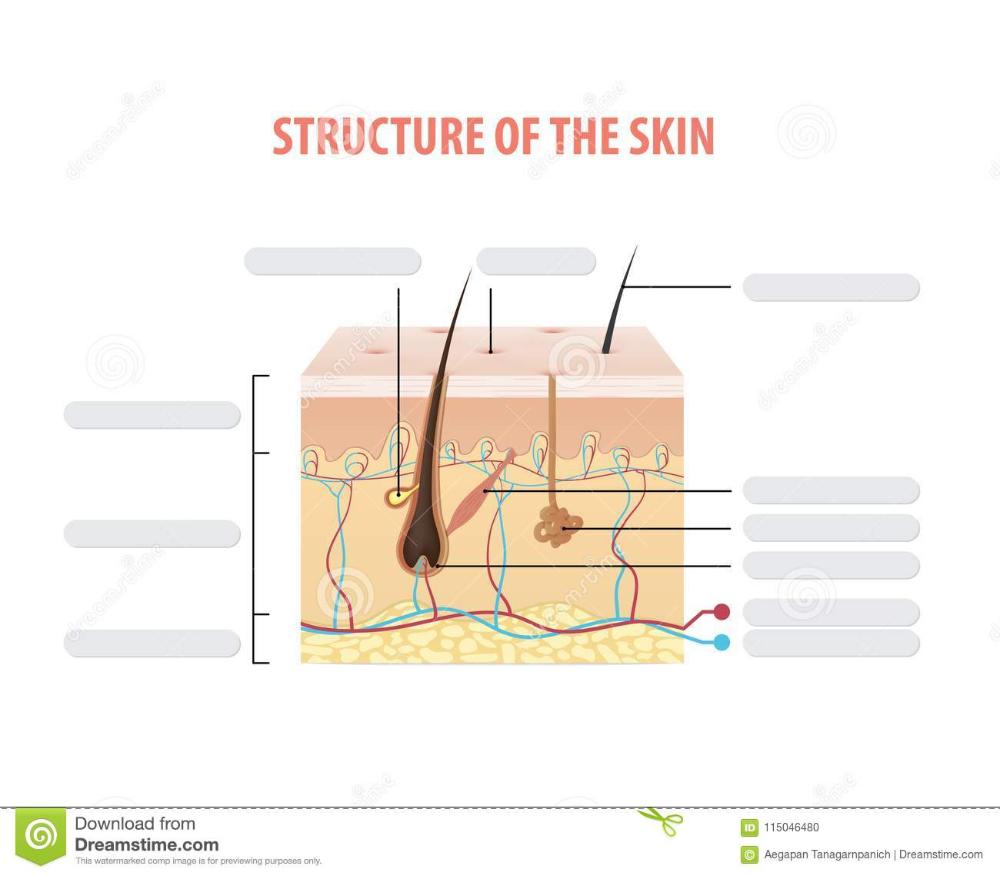
Skin Structure
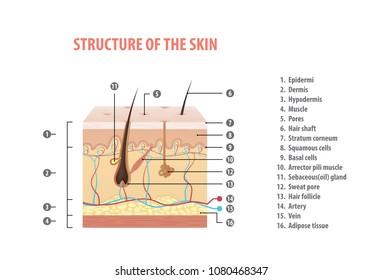
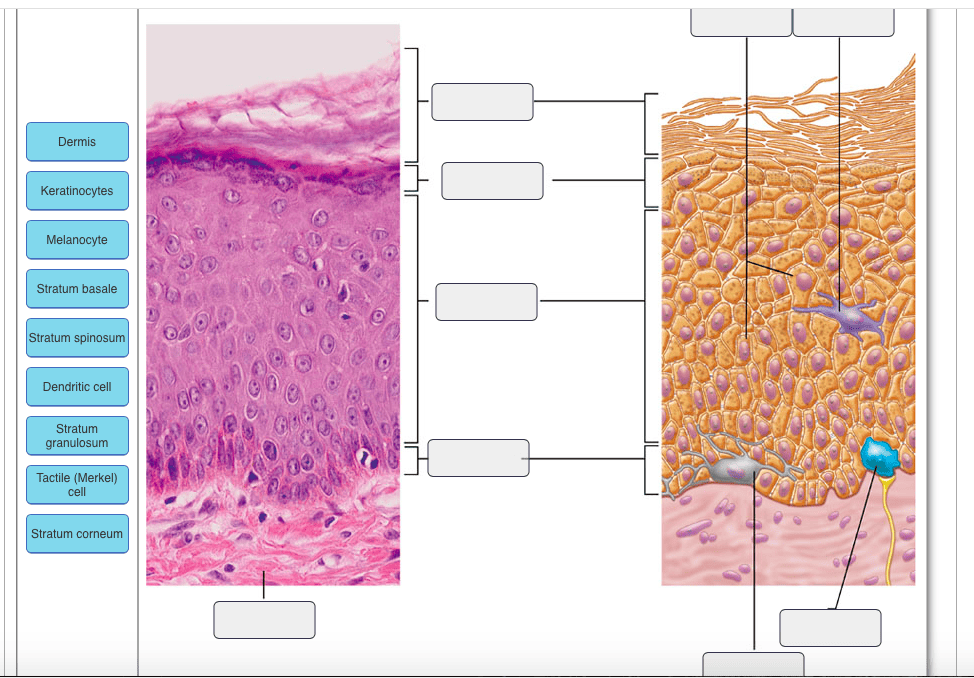
Epidermal Cells and Layers of the Epidermis
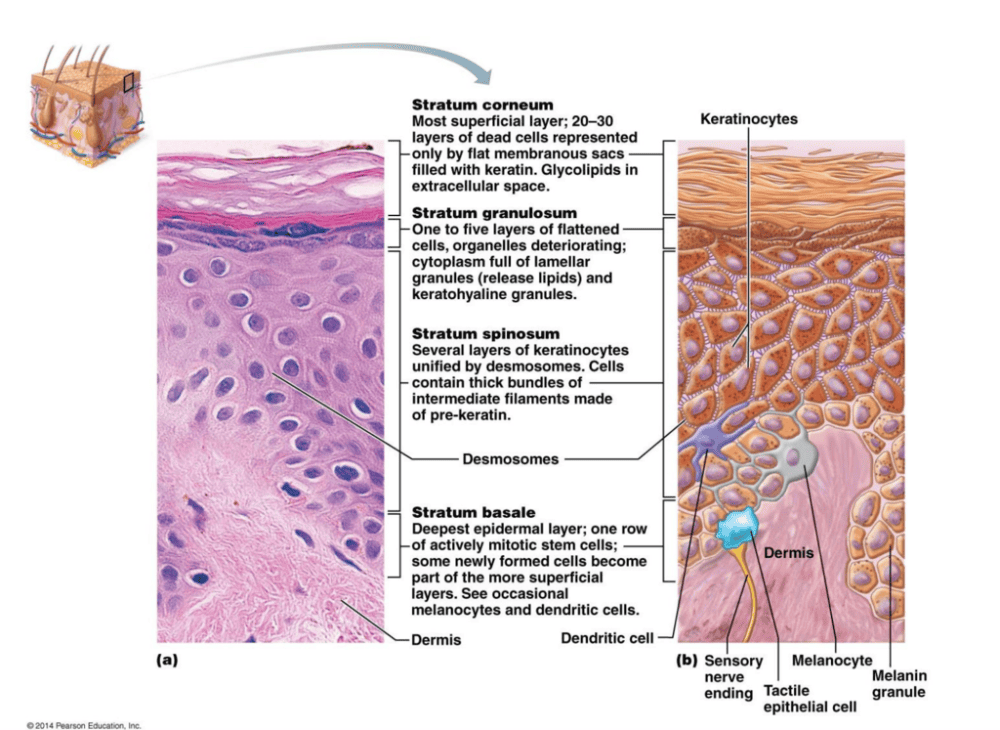
Light micrograph of the dermis
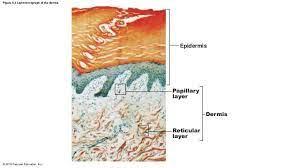
Cleavage Lines
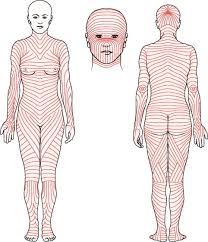
Flexure lines
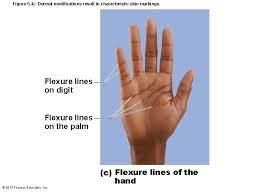
Friction Ridges
